by Craig Brelsford
Founder, shanghaibirding.com
Seen at Pudong’s Cape Nanhui on 4 June: Kamchatka Leaf Warbler Phylloscopus examinandus. Veteran British birder Michael Grunwell and I found our 4 Kamchatkas in Microforest 4 (30.953225, 121.959083), the largest of the tree plantations on the landward side of the sea wall. The species is an all-time first for the Shanghai eBird list.
Just after sunrise, Michael and I, as is our wont, were doing “drive-by birding”—creeping along the edge of the road, listening out for birds. Suddenly, I heard an unfamiliar sound.
My gut said, “Hard, loud—Taiga Flycatcher?”
Taiga was not even close, of course. Note, however, what my gut was not saying: “Arctic Warbler,” a bird whose call I know well. This call was decidedly not an Arctic’s, though it soon dawned on us that we were hearing some type of leaf warbler.
To see why my gut did not say Arctic, compare my recordings of the tight tzit call of Arctic Warbler with the looser call of Kamchatka Leaf Warbler:
Arctic Warbler Phylloscopus borealis, Jiangsu (32.560095, 121.041956), China, May (00:09; 1.9 MB; Craig Brelsford)
Kamchatka Leaf Warbler P. examinandus, Microforest 4 (30.953225, 121.959083), Cape Nanhui, Shanghai, 4 June (00:25; 4.9 MB; Craig Brelsford)
Michael and I skidded to a stop and poked our heads into the green tangle of locust trees. The call was being followed by a song. Only upon hearing the song did I think of Arctic Warbler. But here too, the song, though similar, was distinctive—wavier than the straight trill of Arctic. Look at the spectrograms below.
The spectrogram above is of my recording 4 June of Kamchatka Leaf Warbler. Note the pattern: downward sweeps followed by an upward sweep. No one would liken that song to an insect’s. Below, the spectrogram of my recording of the song of Arctic Warbler. Note the straight, cricket-like trill.
Here are the recordings whose spectrograms are shown above:
Arctic Warbler, Yikesama National Forest, Inner Mongolia (52.150833, 121.465639), China, July (01:00; 3.2 MB; Craig Brelsford)
Kamchatka Leaf Warbler, Microforest 4 (30.953225, 121.959083), Cape Nanhui, 4 June (00:48; 9.3 MB; Craig Brelsford)
After hearing several song-call cycles, Michael, my more experienced partner, first said the words “Kamchatka Leaf Warbler.”
Michael has birded the Indonesian islands of Flores and Komodo, where Kamchatka Leaf Warbler winters. Michael said that, last winter, walking through the forests there, he heard dozens of times the call of P. examinandus.
“I know that call,” Michael said.
I whipped out my Olympus DM-650 voice recorder and recorded the calling and singing warbler. Meanwhile, we caught our first glimpse of the individual. It was clearly an “Arctic-type” leaf warbler.
What is an “Arctic-type” leaf warbler? An Arctic-type leaf warbler is a member of one of four closely related taxa divided among three species: Japanese Leaf Warbler Phylloscopus xanthodryas, Kamchatka Leaf Warbler P. examinandus, and Arctic Warbler P. borealis borealis and P. b. kennicotti.
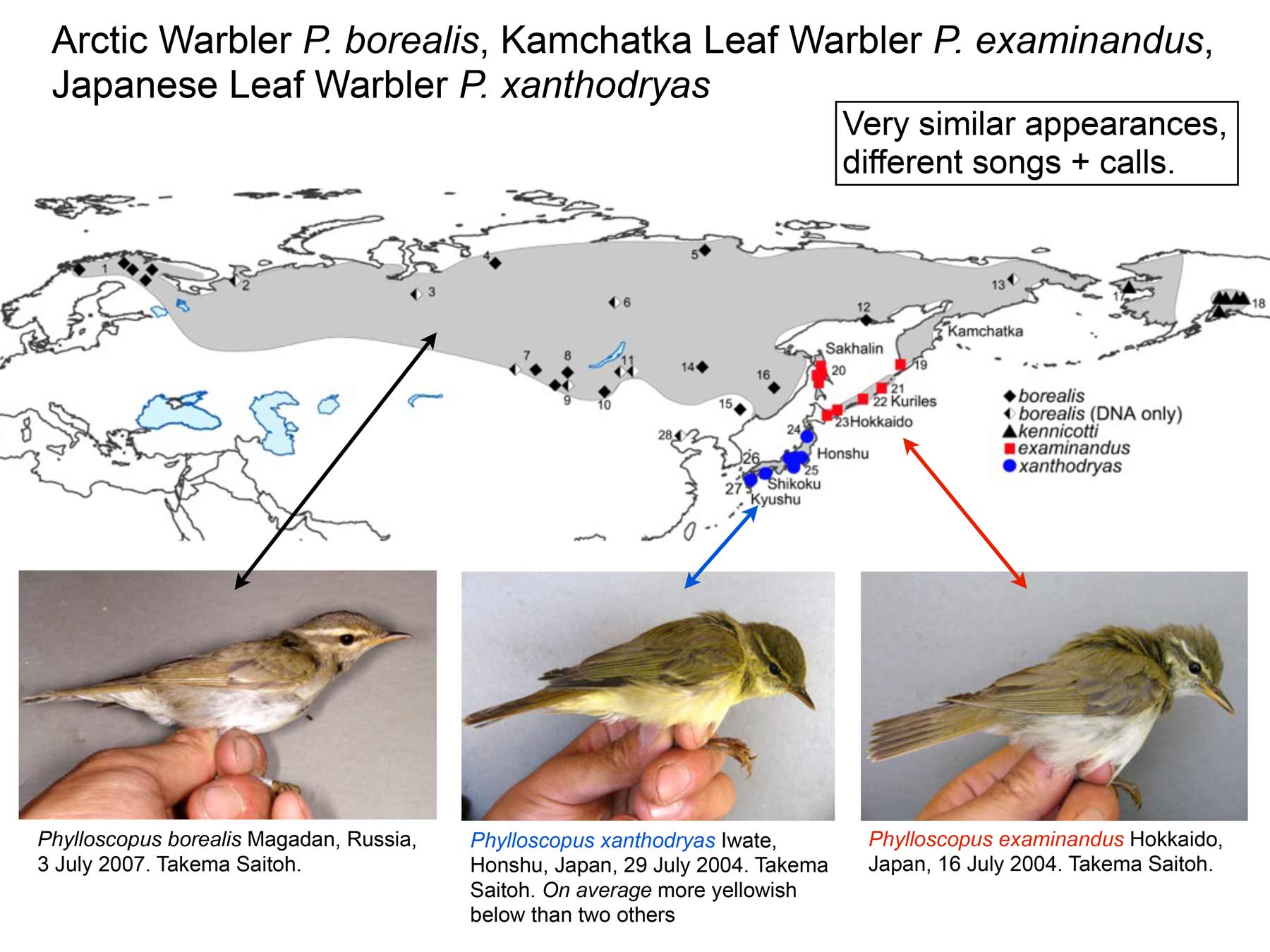
Arctic Warbler is by far the most widespread breeder in the complex. P. b. borealis breeds across northern Eurasia, from Scandinavia to northeast China and the Russian Far East. P. b. kennicotti breeds in western Alaska.
As their names suggest, Japanese Leaf Warbler breeds mainly in Japan (Honshu, Shikoku, Kyushu), Kamchatka Leaf Warbler mainly in the southern Kamchatka Peninsula (as well as on Hokkaido and Sakhalin and in the Kuril Islands).
In 2010 Shanghai Birding member Per Alström et al. proposed the current way of viewing the Arctic-type warblers. Previously, the taxon examinandus was putative, not even reaching the subspecies level; Alström and his team showed that examinandus, with its distinctive song and call, merits recognition not as a subspecies of Arctic Warbler but as a species in its own right.
Of the three Arctic-type species, Japanese Leaf Warbler most stands out, being on average yellower than the two others. Arctic and Kamchatka look much more alike.
There are, however, some slight differences. Kamchatka is said to have a “marginally longer bill, tarsi and tail” than Arctic (del Hoyo & Collar). Sure enough, the Kamchatka I photographed is long-billed. Take a look below.
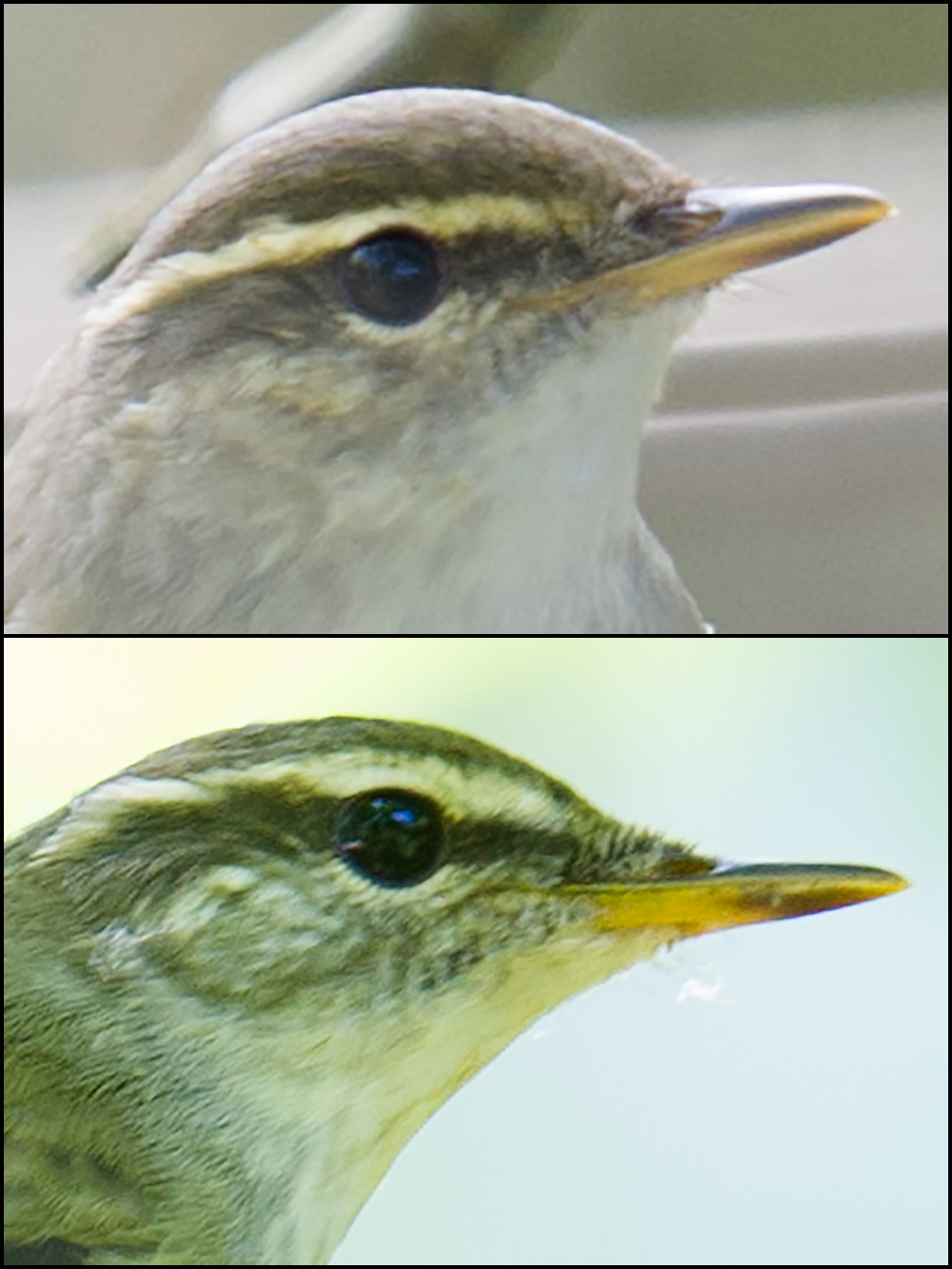
Michael and I heard our loudest song and calls during that first, early morning encounter. However, we heard Kamchatka calling throughout the day.
Our new Shanghai record, combined with late-May and early-June records from nearby Zhejiang, suggests that in this region, once the wave of Arctics passes through around 15 May, Kamchatka Leaf Warbler may be the Arctic-type to look out for.
BIBLIOGRAPHY
Alström P., T. Saitoh, D. Williams, I. Nishiumi, Y. Shigeta, K. Ueda, M. Irestedt, M. Björklund & U. Olsson (2011). The Arctic Warbler Phylloscopus borealis—three anciently separated cryptic species revealed. Ibis 153:395-410. Available at https://www.shanghaibirding.com/wp-content/uploads/2019/04/Alstrom-et-al-2011-Arctic-Warblers-IBIS.pdf (accessed 15 Apr 2025).
Brelsford, C. (2017). eBird Checklist: https://ebird.org/ebird/view/checklist/S37369822. eBird: An online database of bird distribution and abundance [web application]. eBird, Ithaca, New York, USA (accessed 20 Sep 2022).

Brelsford, Craig, moderator. Shanghai Birding, a WeChat group. Discussions with various birders, chief among them Hangzhou birder Cheng Qian, who had information about sightings of P. examinandus in Zhejiang. Beijing-based Swedish birder Jan-Erik Nilsén also provided timely advice. To join Shanghai Birding, in WeChat, friend Craig Brelsford (WeChat ID: craigbrelsford). In your friend request, please make it clear that you wish to join Shanghai Birding.
del Hoyo, J. & Collar, N. (2017). Kamchatka Leaf-warbler (Phylloscopus examinandus). In: del Hoyo, J., Elliott, A., Sargatal, J., Christie, D.A. & de Juana, E. (eds.). Handbook of the Birds of the World Alive. Lynx Edicions, Barcelona, Spain (retrieved from https://doi.org/10.2173/bow.arcwar2.01 on 20 Sep 2022).
Jackett, N. (25 Feb. 2016). First Kamchatka Leaf Warbler recorded for Australian Mainland. eBird Australia: https://ebird.org/content/australia/news/first-recorded-kamchatka-leaf-warbler-for-australian-mainland/. eBird, Ithaca, New York, USA. ebird.org (accessed 20 Sep 2022).
Featured image: Kamchatka Leaf Warbler Phylloscopus examinandus. At Shanghai’s Cape Nanhui, birders Michael Grunwell and Craig Brelsford found the individual pictured here and three others. (Craig Brelsford)

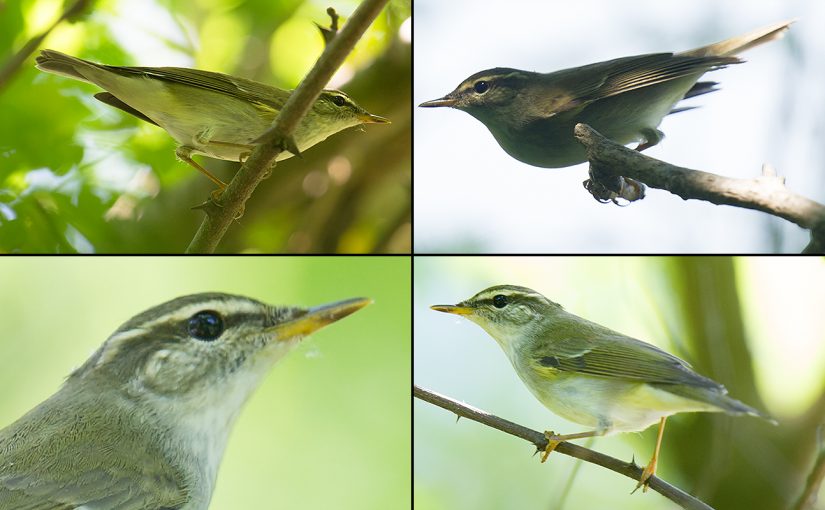
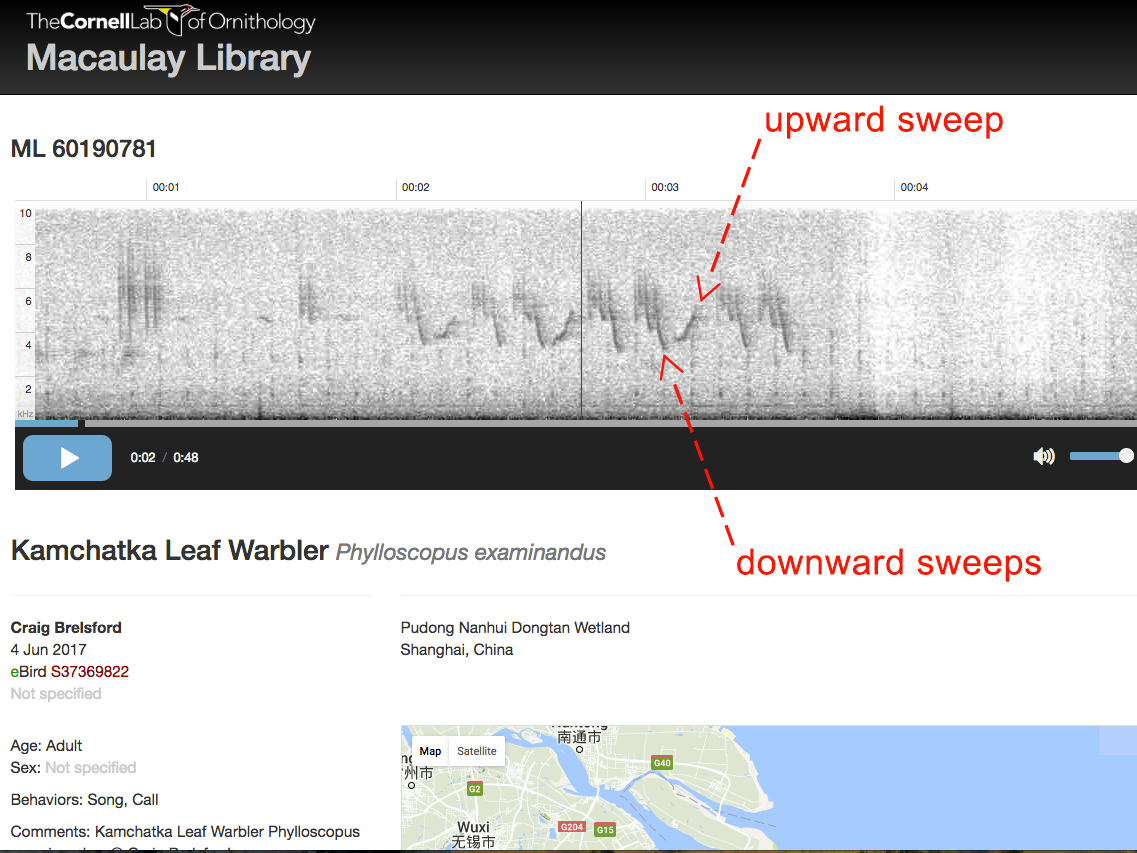
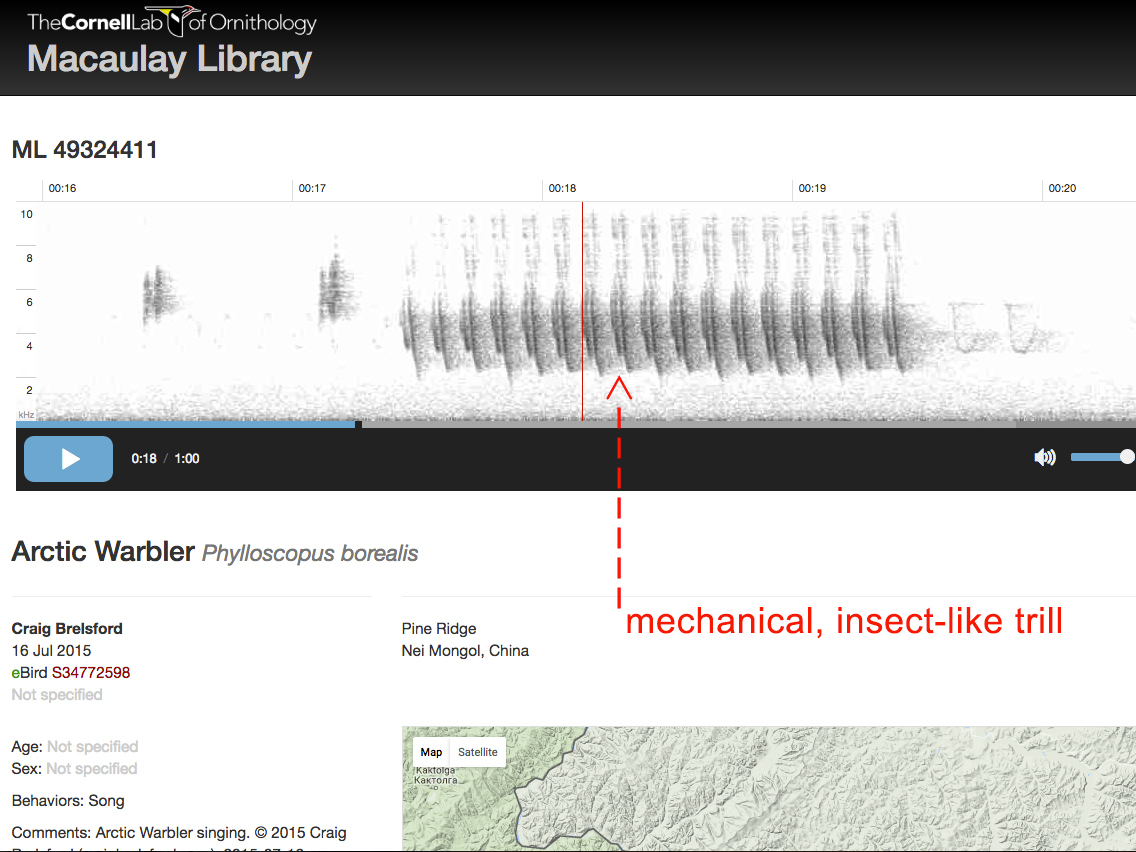
Nice find! I am still fervently trying to learn my leaf warblers. What would you make of the bird I label as an Arctic in this eBird checklist (sorry the picture quality is not great, I took the photo using my binoculars and a phone)? http://ebird.org/ebird/view/checklist/S37169455
Hi Alex, Nice work with binoculars and phone. Unless I hear an Arctic-Kamchatka leaf warbler singing or calling, I am not going to call it to species. Among Arctic and Kamchatka (as well as Japanese Leaf Warbler), songs and calls have little or no overlap; plumage and bare parts have much overlap.
I think that Arctic is the default Arctic-type leaf warbler in Shanghai around 19 May (your list is dated 19 May 2017). But I don’t know. It is highly possible that Kamchatka has been overlooked in Shanghai.
Birding in China is still a new hobby, even in Shanghai, and birders here have been few, inexpert, and isolated. All that is changing now for the better, but we still lack a high-definition picture of birding in Earth’s greatest city.
The fun of birding in China is that so much is not known. We want to proceed carefully and build up a base not of speculation but of knowledge.
Good stuff Craig! I finally nailed my first definite Kamchatka (based on sub-song and calls) in early May here in Bangkok. Now I want to see how easy it is to do them on call alone on autumn passage.
I agree that an ID based solely on field-based plumage/bill structure would be utter folly at this stage, but I note that one (silent) bird I photographed in mid-May last year does look extremely long-billed (see this post http://bangkokcitybirding.blogspot.com/2016/05/laem-pak-bia-17th-may.html).
Hi Dave, Continued great work with Bangkok City Birding. I just read your post. Your Arctic-type is indeed long-billed, and the late date of your record is suggestive, but as your warbler was silent, an ID to species is out of reach. At least that’s my take.
Next time throw some playback at your Arctic-type. Sometimes you’ll get an immediate response.
Note also that Michael and I were having delayed reactions this past Sunday. We would stop the tape and be milling around, then after about five minutes we’d hear a Kamchatka call. So don’t give up, even if the answer is not forthcoming.
You will, I predict, nail autumn Kamchatka and Arctic ID on call alone. The best way will be to get recordings and study the spectrogram. You will see distinctive shapes that will point to one or the other species.
This method is probably more reliable than the human ear alone–though as I note in the post, Michael and I were getting a very strong non-Arctic impression from simply hearing the call (and song) of our Kamchatkas.
Well done, Craig! And fantastic shots as usual…
I actually believe most “Arctic type LW” in the Shanghai area in the beginning of June are examinandus. Have had a number singing at the Magic Car Park and at my compound at that time of year when I lived in Shanghai.
My experience is that borealis will peak a week or two earlier.
Still need xanthodryas for the China list. Get the impression they migrate along a slightly more eastern route.
Cheers,
jocko
Great to hear from you, Jocko! You did a lot over here and we feel your absence.
Congrats on the Kamchatka Leaf. Would expect this first confirmation to open up the door a little in your area–as Kamchatka Leaf is common during migration here on the Korean side of the Yellow Sea (dozens in a day). I am not yet convinced that there is much of a difference in dates in the peak numbers of Arctic and KLeaf during northward migration (both seem to peak in the last few days of May here), but without proper analysis records perhaps suggest that the period of occurrence is rather shorter in KLeaf than in Arctic, as befits a species with a much less extensive breeding range. In this way, most early Arctic-types here (personal first from the second week of May most years) turn out to be Arctics; while both species are still coming through to about June 10th, with most of the latest birds (in mid-June) apparently Arctic again.
Images from Japan tend to suggest that KLeafs can be really quite yellowish below. Most here in Korea tend to have more yellow tones than most Arctic, largely concentrated on the throat, and in a broken line down the centre of the breast and belly. Most Arctics in spring tend to look grey-washed on the breast sides, often with streaking. JLeafs–at least obvious ones–are much prettier, with a better-defined head pattern (stronger sublateral crown stripe) and clean yellows and greens and whites. To a birder originating from western Eurasia, they can recall Wood Warbler. They are much scarcer here than either KLs or Arctics, but also occur somewhat regularly–especially perhaps through the southwest (and southeast) in both spring and autumn. Expect they should also occur in Shanghai.
Great, great stuff. Thanks for lending us your considerable expertise. What a perspective you offer from the “other” side of the Yellow Sea!
I strongly suspect that Kamchatka Leaf Warbler has been overlooked in Shanghai, and that with more and more birders communicating ever more easily over social media, more records are sure to come. Maybe even Japanese Leaf Warbler, too—I am heartened by your theory that we should be finding them here.
Also, thank you once again for your amazing guest post, An Introduction to the Three Widespread Herring-type Gulls in East Asia, published on this site this past April. Readers, if you haven’t savored Nial’s piece yet, now is the time!
This morning I visited Shanghai’s Century Park. I saw a leaf warbler I wanted to get some feedback on. It was fairly large and brown with a white supercillium and no wingbars, but a little edging on the flight feathers. Also brownish on the sides underneath. It was singing steadily (chewy chewy chewy chewy chewy chewy) from inside a large bush and moving around methodically. Periodically it would move through a window, and I would get clean looks. This seems good for Dusky Warbler, and the song matches with what’s on XenoCanto, but there are no reports on e-bird for Dusky Warbler in Century Park for May. But there aren’t a lot of reports for other leaf warbler either, except yellow-browed, which I also had. Is this a reasonable bird to see in Shanghai in May, or am I off in my ID? Perhaps there are some other species I should be looking at?
Hi Bryce,
You describe your leaf warbler well, and you performed sound scientific investigation. Great observation that Dusky Warbler is unrecorded in May at Century on eBird. Your instincts are good. You may wish to incorporate into your habits the habit of whipping out your iPhone and getting a quick sound-recording of tricky birds.
I trust that you paid close attention to the sound your leaf warbler was making, and I furthermore trust that you remembered clearly the sounds you’d heard when you opened up xeno-canto.org. I’d even go so far as to say that your leaf warbler may well be Dusky Warbler.
If I could somehow listen to a sound-recording of the bird you observed, then I likely would be able to confirm beyond doubt that it was Dusky. In fact, you likely wouldn’t have even needed me to tell you.
Please excuse my frankness; I’m acting in the spirit of science and only suggesting ways for you to improve.
Shanghai is still spottily covered, even popular parks like Century; and it is still not known exactly what birds are going through when.
Dusky can sometimes look like Arctic Warbler-type leaf warblers, and sound is the best way to confirm the ID of Dusky vs. Arctic-type. Sound, furthermore, is the only reliable way to distinguish in the field among the three Arctic-type warblers, as I hope this post has made clear.
Thanks for your post, Craig, I have learnt a lot here. This spring I had two Kamchatka LW in Shanghai, one on May 15 in the campus of Donghua University in Songjiang, the other the next day at Nanhui. Both were well sighted and identified by song. The Songjiang Kamchatka was singing alongside two Arctic warblers. I had recording of the first, and photo of the second:
https://www.inaturalist.org/observations/12538622
https://www.inaturalist.org/observations/12538612
Thank you again for including me in these dispatches; they are often phenomenally useful, lucid and insightful; truly examinandus in its best sense.
My best wishes and please stay Healthy in a time of Covid. I wish your wife the same sentiment with two Brelsfords to guide through this difficult time.
Regards, Colm Moore
Many thanks, Colm. Lying low in this difficult time, I open the archives and relive great birding moments in China.
Dear Craig,
I’m looking for an european guide on Bird of Europe, a beautiful picture of Kamchatka Leaf Warbler. I found incredible pictures here from you.
Is it possible to send me one picture in exchange of copy of the book ?
Many thanks for your answer.
Regards from France
Auré